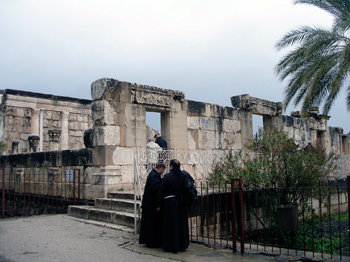
Israel: The North Shore Of The Sea Of Galilee
by Troy Herrick
After leaving Nazareth and before meeting his appointment with destiny in Jerusalem, Jesus started his ministry along the scenic north shore of the Sea of Galilee, the largest fresh water lake in modern day Israel. The four canonical Gospels are filled with miracles that Jesus performed while preaching the good news in this region. A number of these miracles were performed in remote or unidentifiable locations which have subsequently been lost to history.
Present day visitors to Sea of Galilee will discover “traditional” locations for some of Jesus’ miracles. Early Christian pilgrims selected these sites with little more than faith. Unfortunately no archeology is available from Jesus’ time to confirm the locations that were selected.
While Capernaum does have some archeological evidence, the locations of the present day Church of the Primacy of Peter, the Church of the Multiplication of the Loaves and Fishes and the Church of the Beatitudes appear to have been selected largely because of their natural land formations and geographic features. At the same time, visitors to this region should remember that their visit is one of faith and not one of archeology. The miracles that were performed are more important than the actual locations where they were performed. You can start your own pilgrimage of faith at Capernaum.
Capernaum
 Jesus settled in the ancient fishing village of Capernaum after having left Nazareth (Matthew 1:13, 9:1, Mark 2:1). Entering this archeological site today, you are greeted by a statue of St. Peter set just inside the “not-so-pearly” gates. Looking around, you may be surprised that the site before you is from the Byzantine Period and that nothing remains from the time of Jesus.
Jesus settled in the ancient fishing village of Capernaum after having left Nazareth (Matthew 1:13, 9:1, Mark 2:1). Entering this archeological site today, you are greeted by a statue of St. Peter set just inside the “not-so-pearly” gates. Looking around, you may be surprised that the site before you is from the Byzantine Period and that nothing remains from the time of Jesus.
Your first stop is the House of St. Peter. Where do you find it? Just look for the “flying saucer-like” church set upon columns and you will find the traditional site of the St. Peter’s house directly beneath it. This brings new perspective to Peter being the rock upon which Jesus would build his church.
The stone and mortar ruins are those of successive churches built between the 2nd and 7th centuries CE. The 5th century church in particular was octagonal in shape and you can still see the dusty outline of its walls.
Although you will not be able to see it, there is one room inside this complex that contains ancient graffiti, dating to the mid 1st century CE, mentioning Jesus by name. Is this the actual room where Jesus cured Peter’s wife of fever (Luke 4:38) and where a paralytic was lowered down through the roof for Jesus to cure (Mark 2:1-12)? There is no way to confirm this.
As we looked out over the ruins, a black and grey striped cat sitting on top of one of the wall remnants, stuck its tongue out in our direction as if to say “I can go inside but you can’t”. For a different view of St. Peter’s home, enter the church above and look down below through the glass floor at the center of the room.
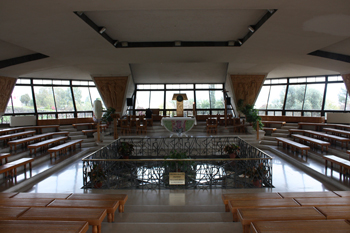 The octagonal shaped Catholic Church is beautiful in its own right. The brightly lit room features eight wooden carvings depicting the life of Jesus lining the periphery. Your eyes are drawn to the altar with the panoramic view of the Sea of Galilee behind it. From here, it is easy to imagine fishermen in their boats casting their nets into the lake.
The octagonal shaped Catholic Church is beautiful in its own right. The brightly lit room features eight wooden carvings depicting the life of Jesus lining the periphery. Your eyes are drawn to the altar with the panoramic view of the Sea of Galilee behind it. From here, it is easy to imagine fishermen in their boats casting their nets into the lake.
After leaving the church pass by the stone ruins of homes from this ancient town and make your way to the ancient synagogue located nearby. Built from imported white limestone, this synagogue dates to the 4-5th centuries CE. Stone benches line the eastern and western aisles of the original room. Three doors are located on the south side of the structure and columns to support the roof line the other three walls. A fresh rain brought an ice-like sheen to the synagogue’s dark flooring slabs.
A black basalt stone wall found beneath the present structure is believed to be from an earlier synagogue. The stone flooring set under the podium in the central prayer hall dates to the 1st century CE. Is this the synagogue in which Jesus taught (John 6:54) and cast out demons (Luke 4:31-33)?
After a leisurely walk around ancient Capernaum and along the lakeshore, drive to your next destination which is the Church of the Primacy of Peter.
The Church of the Primacy of Peter (Sacellum Primatus Sancti Petri)
 Constructed in 1933 on a rocky base at the shore of the Sea of Galilee by the Franciscans, this modest grey stone chapel is not the first church constructed on site. You can still see the remains of walls from an earlier church built in the 4th century CE on three sides of the building.
Constructed in 1933 on a rocky base at the shore of the Sea of Galilee by the Franciscans, this modest grey stone chapel is not the first church constructed on site. You can still see the remains of walls from an earlier church built in the 4th century CE on three sides of the building.
This church commemorates the reinstatement of Peter as chief among the Apostles (John 21: 1-24) after having been rebuked by Jesus near Caesarea Philippi (Matthew 16:13-19) and denying him three times before the crucifixion (Matthew 26:69-75, Mark 14:66-72, Luke 22:55-62, John 18:25-27).
 The focal point of this church is the brown limestone outcrop that seemingly serves as a barrier between the congregation and the altar. According to tradition Jesus laid out a meal of bread and fish for his disciples upon this rock known as the Mensa Christi. You can easily imagine a number of tired fishermen coming ashore after a long night in their boat and finding a warm meal waiting for them, prepared by a man who had risen from the dead.
The focal point of this church is the brown limestone outcrop that seemingly serves as a barrier between the congregation and the altar. According to tradition Jesus laid out a meal of bread and fish for his disciples upon this rock known as the Mensa Christi. You can easily imagine a number of tired fishermen coming ashore after a long night in their boat and finding a warm meal waiting for them, prepared by a man who had risen from the dead.
Exit the church and move around the back toward the water. Your first discovery is a statue entitled “Feed My Sheep” which depicts Peter kneeling in front of Jesus. While they appear to be life-sized in height, the lanky figures have an unearthly appearance to them.
Descend the rough hewn steps just beyond the statue and go down to the lakeshore. At low tide, you find six heart-shaped double-column blocks embedded in the sand, known as the Twelve Thrones which commemorate the Twelve Apostles (Luke 22:30).
Your next destination, the Church of the Multiplication of the Loaves and Fishes, is also considered by some to be the site of Jesus’ last meal with his disciples.
The Church of the Multiplication of the Loaves and Fishes (Church of the Heptapegon)
The present Greek Orthodox church on site, constructed in 1982, commemorates Jesus’ miracle of multiplying five loaves of bread and two fish to feed 5,000 people (Luke 9:10-17, John 6:1-15, Matthew 14:13-21, Mark 6:30-46). There is no proof that this miracle actually occurred on site as Mark only mentions that it occurred in a remote place on the shore of the Sea of Galilee.
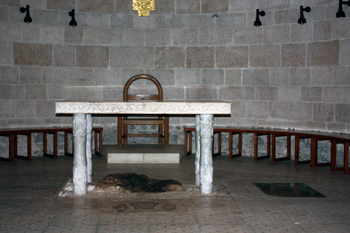 The focal point of this church with its basic interior is the dark brown limestone rock located beneath the simple stone altar. The faithful believe that this 0.6 square meter (5.4 square foot) stone was used by Jesus as a table when performing the miracle. History records that pilgrims have chipped away pieces of this stone over time.
The focal point of this church with its basic interior is the dark brown limestone rock located beneath the simple stone altar. The faithful believe that this 0.6 square meter (5.4 square foot) stone was used by Jesus as a table when performing the miracle. History records that pilgrims have chipped away pieces of this stone over time.
Set in front of the altar is a mosaic depicting two fish straddling a basket of loaves. This mosaic, which appears to have sustained some water damage over the ages, as evidenced by three stains, is quite distinct from the larger mosaic that serves as the church floor. This mosaic displays birds and flowers. Dating to the 5th century, these mosaics were part of an earlier church that was destroyed by the Persians in 614 CE.
After exiting this church, your next destination is further away from the lakeshore than the other sites you will visit – the Church of the Beatitudes.
The Church of the Beatitudes
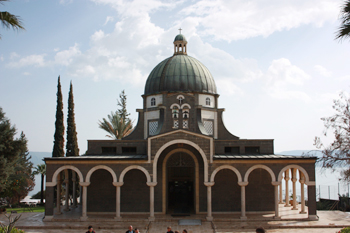 The Catholic Church on site, built in 1937, is set on the traditional site of Jesus’ Sermon on the Mount (Luke 6:20-22, Matthew 5:1-5). While there is no proof that the sermon actually occurred here, pilgrims have been drawn to this site since the 4th century CE, as evidenced by the ruins of a small church just down the hill from the present house of worship.
The Catholic Church on site, built in 1937, is set on the traditional site of Jesus’ Sermon on the Mount (Luke 6:20-22, Matthew 5:1-5). While there is no proof that the sermon actually occurred here, pilgrims have been drawn to this site since the 4th century CE, as evidenced by the ruins of a small church just down the hill from the present house of worship.
While the modern church is certainly pleasing to the eye, the real attraction is the natural setting. Combine warm sunshine, a panoramic view of the Sea of Galilee and song birds with palm trees, shrubs, flowers and lines from the Beatitudes displayed in the well-manicured gardens and all is right with the world. You may wish to spend a few minutes in quiet contemplation here.
Entering the gray stone church with its weathered green dome, you find an octagonal interior representing the eight Beatitudes. At the center of the room sits an altar adorned with a marble arch over it. Below the dome with its golden mosaic, you find the Latinized sermon set in stained glass around the circumference.
When you are ready to leave your serene surroundings, consider a leisurely drive along the north shore of the Sea of Galilee and just drink in the scenery. With a little imagination, you might just discover your own special setting where Jesus could have performed one of his many miracles.
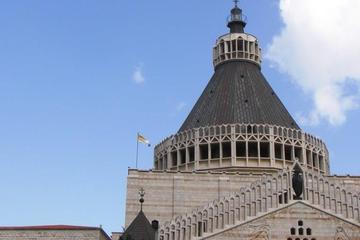
Galilee Christian Tour from Jerusalem
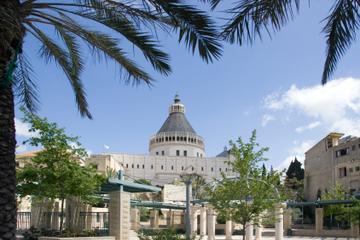
Private Tour: Nazareth, Tiberias and Sea of Galilee Day Trip from Tel Aviv
If You Go:
♦ The sites outlined above are most easily visited in one day with the use of a rental car. Book your rental car through www.plan-a-dream-trip.com/cheap-car-rental.html
♦ Visit the Israel webpage at www.plan-a-dream-trip.com/travel-to-israel.html
♦ Capernaum is located on the shore of the Sea of Galilee 10.8 km (6.73 miles) north east of present day Tiberias. Admission to Capernaum is 5 Shekels.
♦ The Church of the Multiplication of the Loaves and Fishes and the Church of the Primacy of St. Peter are both located at Tabgha. Tabgha is 14 km (9 miles) north of Tiberias. Admission is free to both.
♦ The Church of the Beatitudes is located 3 km (2 miles) north of Capernaum. Admission is free but parking costs 5 Shekels.
About the author:
Troy Herrick, a freelance travel writer, has traveled extensively in North America, the Caribbean, Europe and parts of South America. His articles have appeared in Live Life Travel, International Living, Offbeat Travel and Travel Thru History Magazines. Plan your vacation at his ”PlanADreamTrip.com” sites.
Photographs:
Diane Gagnon is a freelance photographer who has traveled extensively in North America, the Caribbean, Europe and parts of South America. Her photographs have accompanied Troy Herrick’s articles in Live Life Travel, Offbeat Travel and Travel Thru History Magazines.


